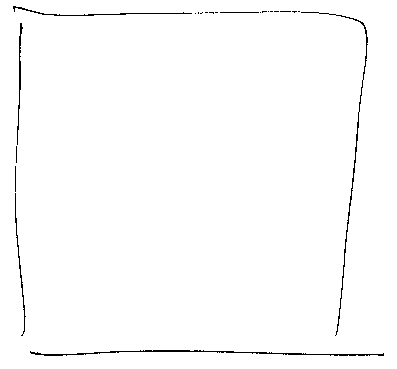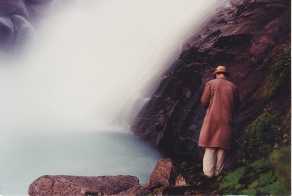Peter Ablinger:
RAUSCHEN
Everything Always
Rauschen (White noise) is the totality of sounds - "everything always" in its acoustic representation. Comparable to white light that contains all colours, white noise contains all frequencies, and - poetically speaking - all music.
The Mirror
Rauschen therefore is maximum density, maximum information. But it is also the opposite: no information, maximum redundancy. For me it is less than nothing, less than silence. Silence ceased to be silent long ago. It is crowded now. Full of ideas, sentimentality, and reminiscences (of privacy, religion, nature, and within music: John Cage). The idea of Rauschen furthermore is not empty: there is the ocean, the noise of trees in the wind, an old analog radio tuned between two stations. The difference between silence and Rauschen becomes clear when we are exposed to it, when we "listen" to it. Cage taught us how many things are left to hear when we listen to silence, that silence does not exist at all. However, being exposed to plain white noise is different. It is not just that we no longer hear the grumbling of our neighbour's stomach. The reason why we hear "less than nothing" is that we cannot connect to it by just listening. It is simply too much. We can't do anything with it. The only thing that is left to do is to produce illusions, i.e., to hear something "in" the noise that is not there, that can be perceived only individually - to project our own imagination onto that white "screen". In this way Rauschen works like a mirror, reflecting back only what we project onto it.
The Plane
Another coherence that guided me to Rauschen ("surface noise"), or to sounds with a high spectral density and relatively static envelope, was the desire for plane. Plane in the sense of a large colour field by Barnett Newman; plane as opposed to figure (Gestalt). In the early 1990's, some forty years after "Onement I", there was nothing in music that came close to that idea. Ligeti had the structural potentiality for plane in this sense, but he was not interested. He was interested in the dynamic shape, the dramaturgic envelope of the orchestral masses. La Monte Young's fifth, from 1960, was so to speak really in touch with plane, and it was probably the most figure-less (gestaltlos) music up to that point. But in opposition to Ligeti Gestaltlosigkeit fullfilled itself here in temporal categories; the vertical (spectral) dimension holds on to the identity and definiteness of a musical interval, a strong remainder of the tradition of musical Gestalt.
But what would be a plane in music? A surface? White or blue? Let's first ask for white. We have already found the equivalence between the "white" and the "everything always". We normally imagine surface as limited. As we cannot limit the borderlines of the spectrum (to still remain "white"), we have left only the time to be defined and quantified. With these questions we really start to get into the subject.
(But I shall anticipate here: Even if I come back to these questions again and again I think they might not be answered in a strict sense. The parallel between visual and musical categories cannot be carried out until to a satisfactory solution. And that's exactly what will rescue us. At some point we have to detach from visual categories and should become aware that with Rauschen we keep hold of one of the rare terms in acoustics that does NOT originate from the visual domain. On the contrary, Rauschen - via information theory - has infiltrated the vernacular as a metaphor and now signifies everything around redundancy and contingency, the incommunicable residuals of figure and information.)

Noise and Noises
English notes on Peter Ablinger's Noise Inquiries by Christian Scheib
Christian Scheib anlässlich der Installation Weiss/weisslich 15
"Weiss", ein Text aus "Metaphern" von Peter Ablinger
"Ruido", Traducción: Sergio Bové
Rauschen
Vor 1994 arbeitete ich abwechselnd an Stücken die immer reduzierter wurden (Ohne Titel/3 Flöten, Ohne Titel/3 Klaviere, Ohne Titel/2 Klarinetten), und solchen die immer dichter wurden (Verkündigung, Grisailles, Der Regen, das Glas, das Lachen). Das war kein wirklicher Gegensatz. Nur etwas das sich unterschiedlich ausprägte. Die Reduktion war wichtig um sich von den Gesten, und von der Vorstellung von Musik als Sprache zu lösen, die Verdichtung war wichtig, um sich von den Einzelheiten, den Motiven und Gestalten zu entfernen (- und auch vom Pathos des Leisen und Langsamen der Feldman- und späten Nono-Stücke, die die späten 90er Jahre prägten). Das Rauschen schließlich hob den (scheinbaren) Gegensatz in sich auf: es war so reduziert wie eine weiße Fläche, und es war so dicht wie alle Musik der Welt gleichzeitig.
Rauschen als Vorstellung oder Metapher durchdringt seit ca. 1990 auch solche Stücke die in Wirklichkeit weit von der akustischen Realität wirklichen weissen Rauschens enfernt sind: Verkündigung, Weisse Litanei, Grisailles; In Weiss/weisslich 3 spielt es als undifferenziert gleichmäßiges, flächiges instrumentales Rauschen die Hauptrolle; In Der Regen, das Glas, das Lachen tritt es auf als eine durchgehende Schicht 6 kontinuierlich tremmulierender Becken, dann als weitere Schicht eines das ganze Stück grundierenden, elektronisch produzierten (weissen) Rauschens, und schließlich als die grundsätzliche Klangarchitektur, welche vom Vordergrund (Ton) zum Hintergrund (Rauschen) in 7 Ensemblegruppen, bzw. Klangschichten vermittelt.
Zu den explizitesten Formulierungen des Rauschens gehören Stücke wie Weiss/Weisslich 18, Baumrauschen, die Aufnahmen 18 verschiedener im Wind rauschenden Bäume, oder Weiss/Weisslich 17a, Klavier und Rauschen, wo die der Reihe nach abgeschrittenen weissen Tasten des Klaviers von weissem Rauschen "eingehüllt" werden.
- "Einige Engel schreien wie das Rauschen von großen Wäldern" (zit. nach Giorgio Agamben, Die Beamten des Himmels, 51)
> listen: waterfall, recording date: 12/1990
> listen to "Study for Rauschen" from 1986
> listen to "Rauschen, Study for Violine" 1992
> listen to "Rauschen, Study for Trumpet" 1992
> listen to "Rauschen, Study for Flute" 1992
> listen to "Rauschen, Study for Tuba" 1994
> listen to "Liste 3" (list 3) for Saxophone and Trumpet, from "13 Rauschlisten" (13 noise lists) 1992
> listen to "Liste 12" (list 12) for fl, sax, trp, perc, vl, cb, from "13 Rauschlisten" (13 noise lists) 1992
Weiss/Weisslich 7
Rauschen in seiner pursten Form - auch, unter anderem, in der Weise, daß gar nichts (Künstlerisches/Künstliches) damit gemacht wurde - begegnet vor allem in "Weiss/Weisslich 7". Die beiden grundlegenden Formulierungen von "Weiss/Weisslich 7" lauten:
WEISS / WEISSLICH 7a: Rauschempfänger (1994)
WEISS / WEISSLICH 7b: Rauschen (1998)
- 7a: noise receiver; e.g. a radio between 2 stations, or tv without antenna; - as a fact, installation, or performance
> white noise received through the ether, documentation
7b: noise; > every form of "Rauschen" (static noise), artificial or natural
Ein Rauschempfänger kann zB. ein Radio sein, das zwischen zwei Sendern eingestellt wird, oder auch ein Fernseher ohne Antenne, und "empfängt" vorzugsweise das der Information gewissermaßen komplemantäre "Weisse Rauschen" aus dem "Äther".
Jenseits der Exitenz des Stücks als pure Tatsache bestand die erste dokumentierte Version - als Studiorealisierung - aus 6 kleinen Weltempfängern die nebeneinander in einer Reihe an die Wand gehängt wurden und rauschten.

Weiss/Weisslich 7a: Rauschempfänger (1994), Foto: Peter Ablinger
Die erste veröffentlichte Version, im selben Jahr in Rümlingen (CH) verteilte dieselben 6 Weltempfänger auf die 4 Wände eines Raumes, sodaß das Rauschen also rundherum zu hören war. - Im übrigen stand die Installation damals in akustischer Verbindung zu zwei weiteren angrenzenden Räumen in denen die Stücke Weiss/Weisslich 6 und Weiss/Weisslich 8 aufgestellt waren.
WEISS / WEISSLICH 7b (1998) erweitert das Konzept auf jegliche Form des Rauschens - künstlich oder natürlich -, und somit auf ein akustisches "Alles", wird doch Weisses Rauschen in Analogie zum weissen Licht als die Summe aller Klänge definiert.
"Vorhandene" Versionen von WEISS / WEISSLICH 7 können danach sein:
ein Wasserfall
ein Springbrunnen
ein Ventilator
eine Brausetablette
die Zentralheizung
der Regen
der Wind
Autobahnen
das Meer
etc.

Peter Ablinger an den Krimmler Wasserfällen, Foto: Siegrid Ablinger
Im Unterschied dazu hier noch einige der realisierten Versionen von Weiss/Weisslich 7:
Klanginstallation mit 18 kleinen Weltempfängern (1997), permanent
"wall drawing" für 2 CD-Player und 4 Lautsprecher (1999), permanent
"Quadrat" für 1 Lautsprecher (1994), 4'
"Quadrat", 16 Weltempfänger (2012)
"Kreis" für 12 Weltempfänger (1996), 12'
"panpiece" für 2 Lautsprecher (1999), 4'
"Selbstportrait einer Wohneinheit", für 8 Weltempfänger, (2004)
"5 Räume", für 2 Lautsprecher, (2004), 3'20"
"Wasserfall", Holzrahmen, Wasserbecken, Schläuche, Pumpe
"N.K. Hallway Piece", 6 oder 12 Weltempfänger (2011)
"Quadrat", 16 Weltempfänger (2012)
"Wonders of Noise", video (2021)
- some of the realized versions of WEISS / WEISSLICH 7:
soundinstallation with 6 or 18 small world-receivers/radios
soundinstallation "wall drawing" for 2 cd-players and 4 loudspeakers
"square" for 1 loudspeaker, 4'
"square", 16 noise receivers
"circle" for 18 world-receivers (1996), 12'
"panpiece"for 2 loudspeakers, 4'
"selfportrait of a living unit" for 8 world-receivers/radios
"5 rooms", for 2 loudspeakers, 3'20"
"waterfall", wooden frame, water basin, tubes, pump
"N.K. Hallway Piece", 6 (12) noise receivers
"Square", 16 noise receivers
"Wonders of Noise", video (2021)
extant versions of WEISS / WEISSLICH 7: a waterfall, a fountain, a fan, effervescent tablet, central heating, rain, wind, free-ways, the sea, etc.
Hier noch ein Gedankenexperiment - eine künftige Realisierung ist aber nicht ausgeschlossen:
WEISS / WEISSLICH 7c, Die Dauer eines Quadrates, eine Umfrage (1995/1998/2004)
- The Duration of a Square, an Inquiry
Abgesehen von zahlreichen Erscheinungen in der Natur und Zivilisation beinhaltet "Weiss/Weisslich 7: Rauschen" gewissermaßen noch eine ganze Reihe weiterer Weiss/Weisslich-Stücke die das Rauschen zum Gegenstand haben, welche aber üblicherweise unter einer anderen Nummer geführt werden.
Siehe etwa die Dokumenationen zu:
Weiss/Weisslich 6, 12 Kassettenrekorder
Weiss/Weisslich 12, Kirchen der Mark Brandenburg
Weiss/weisslich 15, 5 Räume, gefärbte Stille
Weiss/Weisslich 17, Instrumente und Rauschen
Weiss/Weisslich 18, Baumrauschen
Weiss/Weisslich 22, Symphonien
Weiss/Weisslich 24, Kirchen von St.Lambrecht
Weiss/Weisslich 26, Skizzen für ein Arboretum
Weiss/Weisslich 30, Schilf in Töpfen, Wind
Weiss/Weisslich 33, Die Farbe der Nähe
Neben Weiss/Weisslich 17 gibt es noch einen weiteren Zyklus für Instrumente und Rauschen
Texte und Überlegungen von (mit) Peter Ablinger zum Thema Rauschen:
GERÄUSCHHEFT / NOISEPAD 1984-86
RAUSCHEN/HYPOTHESEN, 1991-95
DER WASSERFALL, 1/1993, ein Gespräch mit Karl-Heinz Dicht
RAUSCHEN/STICHWORTE, (1990,)1995
WEISS/WEISSLICH 18, 11/1999
SCHNEE (2), 12/1999
SCHWARZES RAUSCHEN, BLACK NOISE, 2013
(English notes edited by Andrew Smith)
